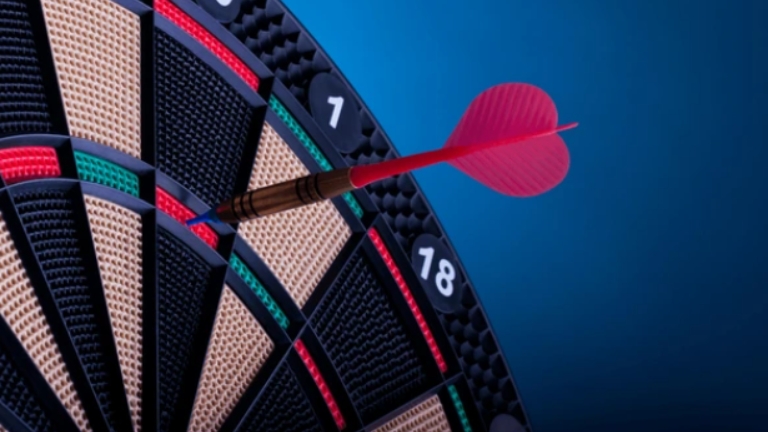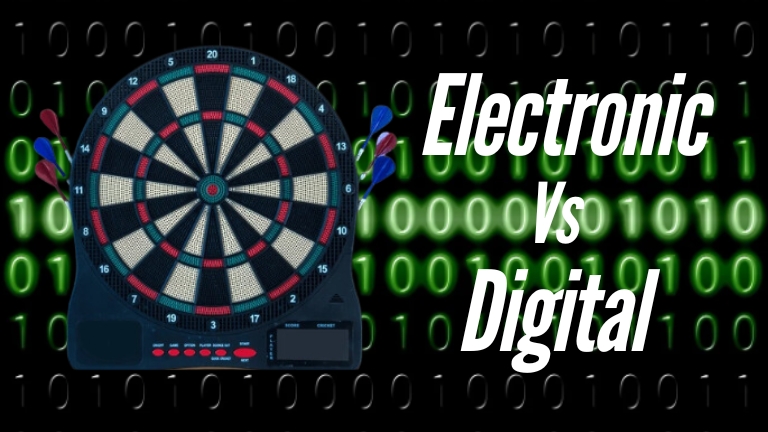When you hear the term “electronic dartboard,” you might also hear people refer to it as a “digital dartboard.” Though the two terms are often used interchangeably, there is a subtle difference in the way they are applied.
To understand why an electronic dartboard is called a digital dartboard, it’s important to break down the technology behind it and the common terminology used.
What is an Electronic Dartboard?
An electronic dartboard is a modern version of the traditional dartboard, designed to offer a more interactive and automated way to play darts. Unlike the standard bristle dartboard, which is purely mechanical, an electronic dartboard uses sensors and a digital display to track scores and game progress automatically. These boards can often accommodate a variety of different games, keep track of player statistics, and even adjust to different skill levels.
The most common type of electronic dartboard features LED or LCD displays, built-in scoring systems, and sensors that register the location of darts on the board. Players don’t need to manually calculate their scores. Instead, the system instantly provides accurate updates after every throw.
What Makes an Electronic Dartboard Digital?
The word digital refers to how data is represented and processed in electronic devices. In simple terms, digital means that data is encoded into a series of numbers, often in the form of binary (0s and 1s), which can be easily interpreted by machines. In the context of dartboards, “digital” refers to the use of electronic sensors and digital displays that process the movements and positions of darts.
The main feature of a digital dartboard is the digitization of scorekeeping. When a dart hits the board, the sensors detect the precise location and calculate the score automatically. The result is then displayed on a digital screen, which is often an LED or an LCD monitor. This makes the game easier to play and more enjoyable, as it removes the need for manual scorekeeping or calculations.
The Relationship Between Electronic and Digital
While all digital dartboards are electronic, not all electronic dartboards are digital. The term electronic simply means that the dartboard uses electrical components to function, such as the sensors, wiring, and the scoring system. The term digital, on the other hand, specifically refers to how the data is processed and displayed.
In essence, every digital dartboard is an electronic dartboard, but the distinction is made to highlight the board’s use of digital technology in tracking and displaying scores. Essentially, when people use the term digital dartboard, they are emphasizing the automated scoring and data display that’s enabled by electronic sensors and a digital screen.
How Does a Digital Dartboard Work?
To fully understand why an electronic dartboard is often called a digital dartboard, it helps to know how the system works.
Sensors: The board is equipped with a series of sensors that detect where the dart lands. These sensors may be capacitive, piezoelectric, or optical in nature, depending on the model. Some systems rely on pressure sensors, while others use infrared light or cameras to detect the dart’s location.
Scoring System: Once a dart is thrown and its position is detected by the sensors, the information is sent to an internal microprocessor. This processor then calculates the score based on where the dart landed (such as a bullseye, triple 20, or other areas on the board).
Digital Display: The results of the calculation are sent to a digital display, where players can see their scores in real-time. These displays are typically made up of LED lights or LCD screens, making the scores easy to read.
Game Options: Many digital dartboards are designed with multiple pre-programmed games. The board can automatically switch between different scoring rules based on the chosen game, such as 301, 501, cricket, or others. The digital system can even track the statistics of each player, such as average score per throw or total points accumulated.
Automatic Calculation: One of the key benefits of a digital dartboard is the automatic calculation of scores. This takes away the need for players to manually subtract points and allows for quicker gameplay. For example, in a standard game like 501, players don’t have to remember complex math to subtract their score from the target number. The digital system does it all instantly.

Advantages of Digital Dartboards Over Traditional Boards
Digital dartboards bring a number of advantages to players over traditional, mechanical boards.
Accuracy: Digital dartboards are far more accurate than their traditional counterparts. The sensors used to detect the dart’s position are designed to ensure that scores are calculated correctly every time, reducing the chance of human error during manual scorekeeping.
Ease of Use: The automatic scoring system makes digital dartboards incredibly user-friendly, especially for beginners or casual players. You no longer need to worry about calculating your score or remembering where your last throw landed.
Variety of Games: Digital dartboards come with a wide variety of pre-programmed games, offering something for every player, from beginners to seasoned professionals. These games include cricket, 301, 501, and more. The board can even automatically adjust to different skill levels to keep things fun and challenging.
Player Statistics: Digital dartboards can track player statistics over time, offering insight into performance, consistency, and improvement. These stats may include metrics such as average score, highest score, or most frequent bullseye hits.
Reduced Maintenance: Unlike traditional dartboards, which may require frequent repairs due to wear and tear (such as dart holes or damaged sections), digital dartboards are built to last longer. Since they are mostly electronic and have fewer parts that wear out, they are often more durable and require less upkeep.
Why the Terms “Electronic” and “Digital” Are Used Interchangeably
In everyday conversation, many people use the terms electronic and digital interchangeably when talking about dartboards. While it’s true that all digital dartboards are a subset of electronic dartboards, the distinction lies in the specific type of technology used for data processing and display.
The use of “digital” may also emphasize the fact that the board is using digital technology to track scores in a way that’s more sophisticated than just basic electronic tracking. Digital technology allows for the creation of complex algorithms that can track scores, calculate statistics, and automatically adjust to various game settings, all of which require a more advanced level of processing.

FAQs
How does digital darts work?
Digital darts uses an electronic dartboard with built-in sensors that detect where darts land. Players use soft-tipped darts, which hit plastic target areas with small holes. The board’s sensors automatically track the dart’s position, calculate scores, and display results on a screen or connected app.
Advanced models allow for online play, enabling players to compete with others around the world. This eliminates manual scorekeeping, improving accuracy and simplifying gameplay.
What is a smart dartboard?
A smart dartboard is an advanced version of an electronic dartboard, designed to enhance gameplay. These dartboards connect to mobile apps or devices via Bluetooth or Wi-Fi, allowing players to track scores, monitor performance, and play online with others globally.
Smart dartboards often feature built-in sensors or cameras that accurately detect dart hits, removing the need for manual scoring. They may also include game modes, tutorials, and training features to help players improve their skills.
Conclusion
The term digital dartboard is often used in place of electronic dartboard to emphasize the sophisticated technology behind the system. While both terms are related to dartboards that use electronic components for automatic scoring, digital highlights the specific use of digital displays and data processing. Understanding this distinction clarifies why the two terms are used interchangeably, even if there’s a more technical difference in their usage.
Whether you call it an electronic dartboard or a digital dartboard, what matters most is the experience it provides. These boards are designed to enhance the game of darts, making it easier, more enjoyable, and more accurate for players at all levels.

